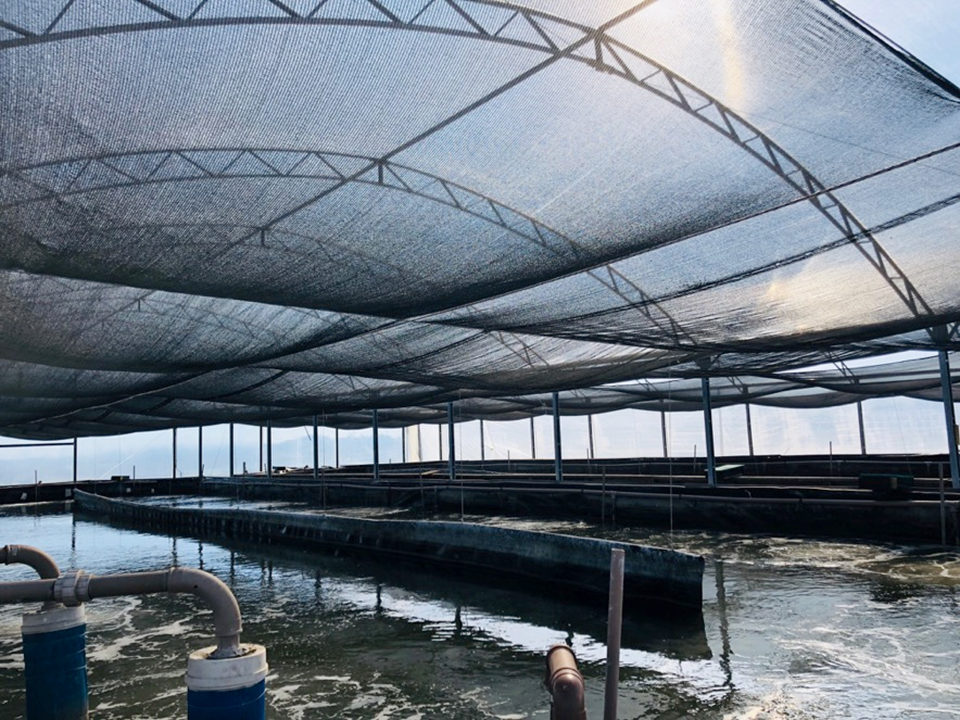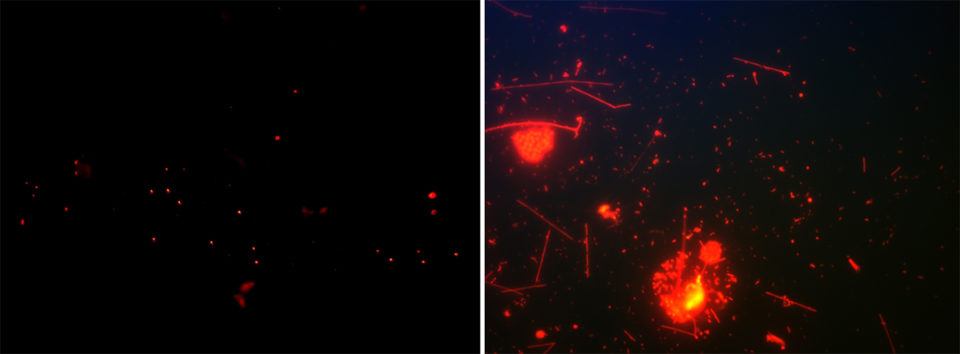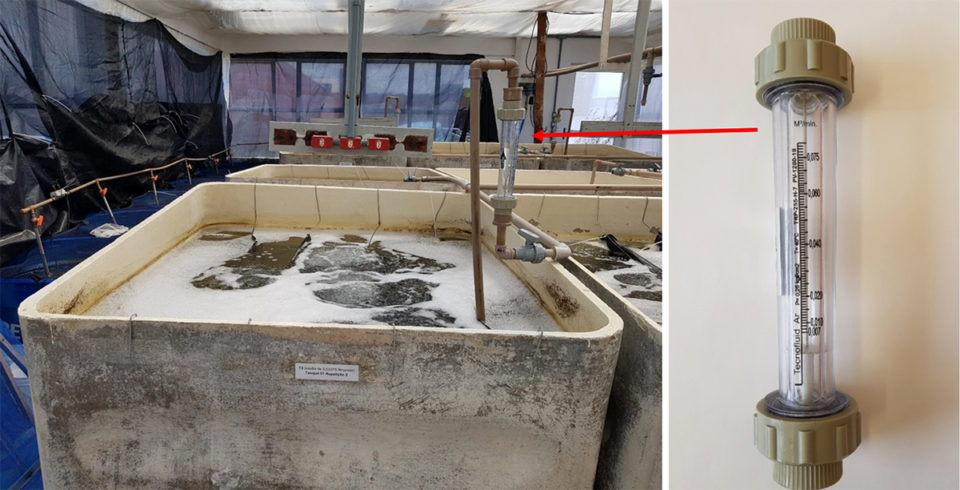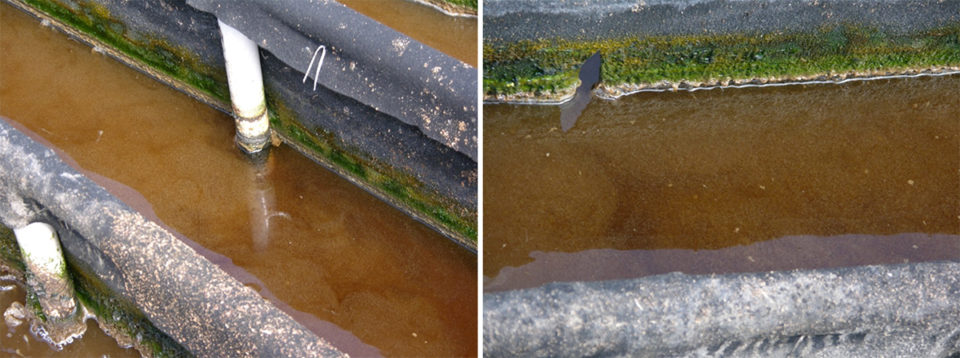Further studies needed to improve understanding of nitrifying bacteria dynamics

Nitrogen compounds are considered one of the main problems in intensive and super intensive shrimp systems. Ammonia and nitrite present the highest toxicities for the organisms produced, affecting their growth, stocking process, feeding and survival. However, these elements can be efficiently absorbed and transformed into additional protein by bacteria present in systems using biofloc technology (BFT).
Despite the major role played by bioflocs, biofilms are also present in BFT systems. A biofilm is a microbial community associated with an organic matrix adhered to a submerged natural or artificial substrate.
The benefits of incorporating biofilm into the production system include improving water quality, availability of supplementary food and prevention of diseases caused by pathogenic bacteria. This is possible particularly because of the predation on bacteria by protozoa, reducing the risk of disease spreading to crops and increasing the availability of natural food such as ciliates, rotifers and nematodes. Despite these advantages, the use of biofilm has not been stimulated in intensive aquaculture systems, mainly due to difficulties in handling large substrates added to enhance the establishment of biofilms.
Recent studies have shown the importance of the microbial community living in biofilms to water quality. Although important, biofilm is less efficient than biofloc in absorbing nitrogen compounds. This probably occurs because, besides the nitrifying bacteria, ammonium is also absorbed by heterotrophic bacteria present in the biofloc. It is likely that such differences in the efficiency of biofloc and biofilm are related to physical and chemical conditions of the water in the aquaculture system.
One of the most important physical characteristics that influences both biofilm and biofloc microbial communities, but in different ways, is aeration. In intensive systems like those using BFT, strong and constant aeration is vital to keep dissolved oxygen at high levels to avoid mortality of the cultured organisms by hypoxia. However, some studies have demonstrated that the action of strong aeration can negatively impact the nitrification process in bioflocs. On the other hand, low aeration levels may limit the oxygen and nutrients absorption by the organisms present in the biofilm.
In this article, we present the first results of experiments conducted with different aeration intensities (measured by rotameters) and its influence on the nitrification process of biofilm and biofloc in BFT systems. The authors are grateful for the financial support provided by the National Council for Scientific and Technological Development (CNPq) and Coordination for the Improvement of Higher Level Personnel (CAPES). Wasielesky, W.J., and Poersch, L.H., are research fellows of CNPq. Special thanks to All Aqua aeration, Trevisan Equipamentos Agroindustriais, Centro Oeste Rações S.A. (GUABI) and AQUATEC for donating the air injectors, experimental diets and postlarvae, respectively.
Study setup
The experiment was carried out at the Shrimp Farming Laboratory, Marine Aquaculture Station, Institute of Oceanography of the Federal University of Rio Grande (FURG)in Rio Grande (RS), Brazil. The experimental setup included twelve 800-liter tanks housed in a greenhouse. Tanks were filled with seawater (30 ppt salinity), chlorinated at a concentration of 10 ppm of sodium hypochlorite, and subsequently dechlorinated with ascorbic acid and constant aeration. For the biofilm formation, non-floating artificial substrates were used (Needlona®), previously matured in a biofloc system, at the surface proportion of 200 percent of the lateral area of the tank. These units were fixed to the top of the tanks and remained submerged throughout the experimental period.
The experimental design consisted of two trials in triplicate. In the first study we analyzed the efficiency of different flow rates in the nitrifying process only in biofilm, to check if the flow rate affect action of ammonium oxidizing bacteria (AOB) and nitrite oxidizing bacteria (NOB, see image below).

To maintain ammonia at the initial concentration of 7.0 mg/L, ammonium chloride (NH4Cl) was added as needed. The study lasted for 10 days, and had the following treatments: T1 (no aeration); T2 (flow rate 7.5 L/minute); T3 (flow rate 33.75 L/minute); and T4 (flow rate 75 L/minute). To assure the exact air flow rate in all treatments, a commercial rotameter (Tecnofluid® TRP-255-H-7 1 POL NPT) was coupled to the aeration system.

Using the best result from the first trial, a second trial was designed including treatments with biofilm and biofloc. A flow rate of 33.75 L/minute was applied to the following treatments: T1 (Clear water + biofilm and flow rate control); T2 (Biofloc + biofilm and flow rate control) and T3 (Biofloc without flow rate control). The substrate for biofilm (Needlona®) was added as described in the first trial.
Pacific white shrimp (Litopenaeus vannamei) juveniles weighing ~ 7.89 grams were stocked at a density of 500 animals per cubic meter in each treatment and this trial lasted for 47 days.
Biofloc formation (T2 and T3) was promoted by the addition of sugarcane molasses as a source of organic carbon to maintain a C:N ratio of 15: 1. Levels of total ammonium nitrogen (TAN) and nitrite (NO2–) were determined every day, and for nitrate (NO3–) once a week. Nitrifying bacteria were imaged using the fluorescent in situ hybridization (FISH) technique.
Results of trial 1
The ammonia concentrations of the T1 (no aeration), T2 (flow rate of 7.5 L/minute) and T4 (flow rate of 75 L/minute) treatments had no statistically significant differences at the conclusion of the trial. However, the T3 treatment (flow rate of 33.75/L) had lower mean values of TAN. The nitrite concentration of treatment T1 (no aeration) had higher values, indicating a delay in the nitrification process in this treatment, while on the other hand the treatments that had controlled flow rates (like T2, and T4) had similar values throughout the study. No differences were observed for nitrate among the treatments (Table 1).
Morais, Biofloc technology, Table 1
| Treatment | T1 | T2 | T3 | T4 |
|---|---|---|---|---|
| Parameter | No aeration | Flow rate 75 | Flow rate 33.75 | Flow rate 75 |
| N-AT (mg/L) | 3.08 ± 2.04a | 2.60 ± 2.16a | 2.52 ± 2.08b | 2.65 ± 2.11a |
| N-NO2 (mg/L) | 0.17 ± 0.08a | 0.05 ± 0.03b | 0.08 ± 0.08b | 0.05 ± 0.03b |
| N-NO3 (mg/L) | 2.21 ± 2.44a | 2.85 ± 3.17a | 3.32 ± 3.33a | 3.55 ± 4.54a |
Results of trial 2
The results for nitrogen compounds of the second trial are presented in Table 2. The concentrations of total ammonia and nitrite were statistically different among the treatments. Treatments T1 (clear water + biofilm and flow rate control) and T2 (biofloc + biofilm and flow rate control) had lower concentrations than treatment T3 (biofloc without flow rate control). The nitrite concentration in treatments T1 and T2 were lower (statistically different) than for treatment T3, and the nitrate concentration did not show a significant difference in the three treatments, although the treatment with biofilm and biofloc (T2) had the largest values.
The performance of the nitrogen compounds (mainly ammonia and nitrite) indicate that the treatments with the presence of biofilm were more efficient, since a community of nitrifying bacteria was already present in the substrate.
Morais, Biofloc technology, Table 2
| Parameter | Clear water + biofilm | Biofloc + biofilm | Biofloc |
|---|---|---|---|
| TAN (mg/L) | 0.70 ± 0.92a | 0.51 ± 0.96b | 1.70 ± 2.96b |
| N-NO2 (mg/L) | 1.11 ± 0.77a | 1.51 ± 2.09a | 15.19 ± 14.20b |
| N-NO3 (mg/L) | 52.61 ± 33.03a | 73.85 ± 83.29a | 43.91 ± 55.66a |
The presence of biofilm in treatments T1 and T2 resulted in smaller concentration of ammonia and nitrite, showing that the microbial community present in the substrates was effective in maintaining the water quality in those treatments. On the other hand, the treatment without substrate (T3) had high values of ammonia and nitrite that exceeded the limits recommended for L. vannamei, which forced a water exchange to keep the water quality levels within the acceptable limits for this species. Therefore, we conclude that the use of vertical substrates was efficient to control the levels of nitrogen compounds present in the experimental system in our study.

Perspectives
Results of our study confirm the importance of biofilm in BFT systems, but also indicate that the analysis of aeration needs be deepened in order to get a better understanding of the nitrifying bacteria dynamics in biofilm and biofloc in BFT systems.
Now that you've finished reading the article ...
… we hope you’ll consider supporting our mission to document the evolution of the global aquaculture industry and share our vast network of contributors’ expansive knowledge every week.
By becoming a Global Seafood Alliance member, you’re ensuring that all of the pre-competitive work we do through member benefits, resources and events can continue. Individual membership costs just $50 a year. GSA individual and corporate members receive complimentary access to a series of GOAL virtual events beginning in April. Join now.
Not a GSA member? Join us.
Authors
-

Ana Paula Mariane de Morais, B.S.
Laboratório de Fitoplâncton e Microorganismos Marinhos
Instituto de Oceanografia
Universidade Federal do Rio Grande (FURG)
Rio Grande (RS), 96201-900, Brasil -

Paulo Cesar Abreu., Ph.D.
Laboratório de Fitoplâncton e Microorganismos Marinhos
Instituto de Oceanografia
Universidade Federal do Rio Grande (FURG)
Rio Grande (RS), 96201-900, Brasil
-

Wilson Wasielesky Jr., Ph.D.
Laboratório de Carcinocultura
Instituto de Oceanografia
Universidade Federal do Rio Grande (FURG)
Rio Grande (RS), 96201-900, Brasil
-

Dariano Krummenauer, Ph.D.
Laboratório de Fitoplâncton e Microorganismos Marinho
Instituto de Oceanografia
Universidade Federal do Rio Grande (FURG)
Rio Grande (RS), 96201-900, Brasil[109,111,99,46,108,105,97,109,103,64,107,111,110,97,105,114,97,100]
Tagged With
Related Posts

Responsibility
Biofloc technology options for aquaculture
Biofloc technology offers advantages for the sustainable culture of shrimp and some species of fish.

Health & Welfare
Biofloc technology: Possible prevention for shrimp diseases
Facing emerging viral problems and rising energy costs, the use of biofloc technology in biosecure systems offers an answer for sustainable shrimp aquaculture. The main attributes of biofloc systems in reducing disease risk include the fact that low water exchange improves pathogen exclusion.

Health & Welfare
Ammonia addition enhances microbial flocs in nursery phase for Pacific white shrimp
In a study, “pre-fertilization” in the nursery phase of a biofloc system for shrimp was tested. The objective was to accelerate the biofloc formation to minimize ammonia concentrations, avoiding high peaks during culture.

Aquafeeds
Biofloc and clear-water RAS systems: a comparison
This study compared two types of indoor, shrimp culture systems: clear-water RAS and biofloc systems. Clearwater RAS had the edge in water quality, but shrimp in the biofloc treatment had a higher feed conversion ratio.

